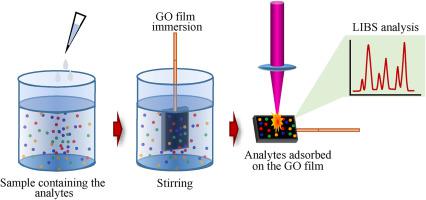Talanta ( IF 6.1 ) Pub Date : 2020-10-05 , DOI: 10.1016/j.talanta.2020.121736 L. Ripoll , J. Navarro-González , S. Legnaioli , V. Palleschi , M. Hidalgo

|
An analytical methodology based in the combination of Thin Film Microextraction with Laser-induced Breakdown Spectroscopy (TFME-LIBS) was investigated, for the first time, for detection of Cu, Cr, Ni and Pb in aqueous solutions. In this methodology, the analytes were extracted in a thin film of adsorbent material deposited on a solid support, which was introduced in the sample to analyse. After extraction, the analytes retained in the adsorbent were analysed by LIBS. In order to obtain adsorbent films useful for the microextraction step, two different experimental procedures for film generation, denoted as Drop Casting Deposition and Mould Deposition, were evaluated. In both cases, graphene oxide was used as adsorbent material. The mould deposition procedure was found to produce more homogeneous graphene oxide layers, leading to more uniform distribution of the adsorbed analytes on the graphene oxide surface. Experimental parameters affecting the TFME procedure, such as the adsorbent amount and extraction time, were studied. Under optimum microextraction conditions, the analytical figures of merit of the proposed TFME-LIBS method were evaluated, leading to limits of detection ranging from 41 μg kg−1 and 52 μg kg−1. Method trueness, evaluated from the analysis of a real sample of bottle water, led to recovery values about 70%, indicating the existence of strong matrix effects probably due to the presence of major cations in the bottle water. After 50% dilution of the sample with deionized water, recoveries values improved to 100%–108%.
中文翻译:

使用LIBS检测评估薄膜微萃取对液体样品中痕量元素的分析
首次研究了基于薄膜微萃取与激光诱导击穿光谱法(TFME-LIBS)结合的分析方法,用于检测水溶液中的Cu,Cr,Ni和Pb。在这种方法中,将分析物提取到沉积在固体支持物上的吸附剂薄膜中,然后将其引入样品中进行分析。提取后,通过LIBS分析保留在吸附剂中的分析物。为了获得可用于微萃取步骤的吸附膜,对两种不同的膜生成实验程序进行了评估,分别称为滴铸法沉积和铸模沉积。在两种情况下,均使用氧化石墨烯作为吸附材料。发现模具沉积程序可产生更均匀的氧化石墨烯层,导致吸附的分析物在氧化石墨烯表面上的分布更加均匀。研究了影响TFME程序的实验参数,例如吸附剂的量和提取时间。在最佳微萃取条件下,对所提出的TFME-LIBS方法的分析品质因数进行了评估,得出的检出限为41μgkg-1和52μgkg -1。通过对瓶装水的真实样品进行分析所评估的方法真实性,得出的回收率约为70%,这表明瓶装水中存在主要阳离子可能导致强烈的基质效应。用去离子水稀释样品50%后,回收率提高到100%–108%。



























 京公网安备 11010802027423号
京公网安备 11010802027423号